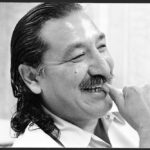Malik Miah
Posted February 25, 2025

AS FORMER U.S. PRESIDENT Joe Biden left office on January 20, he commuted Leonard Peltier’s life sentence in prison to home incarceration. Peltier is a long-time leader of the American Indian Movement.
On February 18 Peltier walked out, standing strong at 80 years from a Florida prison. He served most of his time in maximum security.
Peltier said, “It’s finally over – I’m going home.” Supporters outside the prison, including some who waved flags saying, “Free Leonard Peltier,” were elated.
“We never thought he would get out,” said Ray St. Clair, a member of the White Earth Band of the Minnesota Chippewa Tribe who traveled to Florida to be there for Peltier’s release. “It shows you should never give up hope. We can take this to repair the damage that was done. This is a start.”
As summarized by Peoples Dispatch, “After 49 years and 11 months, Leonard Peltier will finally leave prison. Peltier had his life sentence commuted by outgoing-US President Joe Biden on January 20, hours before Donald Trump was sworn in.
Peltier, the longest-held political prisoner in the United States is 80 years old and suffers from multiple, severe health ailments poorly treated during his nearly half-century incarceration.
Peltier was not pardoned for the killing of two FBI agents which he has insisted for over 50 years he did not commit. He will spend his remaining days in home confinement.
Staunch supporters of Peltier included the African People’s Socialist Party. A forum was held at its Uhuru House in St Petersburg, Florida, where one of Peltier’s attorneys spoke.
Leaders of the APSP and some white allies were recently charged by the FBI as agents of a foreign country (Russia) for their longtime opposition to U.S. foreign policy in Africa and around the world. The Uhuru 3 were acquitted of that charge, but convicted of a lesser charge (under appeal) of conspiracy to become an unregistered agent.
Clenched Fist in Defiance
Buffalo’s Fire, the “Indigenous news from the Indigenous Media Freedom Alliance,” showed a photo of Peltier with a raised clenched fist as he arrived in North Dakota at his home reservation.
The New York Times, the day after Peltier’s release, wrote:
“Leonard Peltier had waited five decades to do something he had increasingly doubted he would ever be able to: say thank you, in person, to the fellow Native Americans and others who had spent those years fighting for his freedom.
“Addressing a raucous crowd of 300 supporters on his home reservation on Wednesday, Mr. Peltier, now 80, pumped his right fist repeatedly and displayed remarkable stamina for a partly blind man who needs a walker.”
Leader of AIM
The Times added:
“Mr. Peltier was a member of the American Indian Movement, or AIM, an advocacy organization founded in 1968 that promoted civil rights, spoke out against police brutality and other abuses, and sought to highlight the federal government’s history of violating treaties it had made with Native American tribes.
“In the 1970s, militant members of the group clashed with federal authorities on the Pine Ridge Indian Reservation in South Dakota. They forcibly seized control of the Sioux village of Wounded Knee and fended off the authorities for 71 days.”
AIM was a militant Indigenous civil rights organizations formed during the youth rebellions of the 1960s. Like many others, such as the Oakland, California-based Black Panther Party, it provided needed social services to its communities and fought for full freedom.
Wounded Knee was a standoff that received worldwide attention. It gained broad support from oppressed communities.
“Two years after the Wounded Knee standoff, with the relationship between Native American activists and federal law enforcement agencies still frayed, two F.B.I. agents — Jack Coler and Ronald Williams — tried to arrest a robbery suspect on the Pine Ridge reservation,” according to the NYT.
“A shootout ensued, leaving the two agents and one activist dead. Mr. Peltier has admitted to firing his gun from a distance but has insisted that he acted in self-defense and was not the one who killed the agents. Of the more than 30 people who were present during the shootout, Mr. Peltier was the only one convicted.
“Exculpatory evidence that had helped to acquit two other AIM members accused in the killings was excluded from Mr. Peltier’s trial — an issue that has frequently been raised by his supporters as an example of injustice.”
Signs that read “50 Years of Resistance“ greeted Peltier as he was whisked to his new home in the town of Belcourt. The house was purchased by NDN Collective, an Indigenous rights group based in Rapid City, S.D., whose leaders greeted Mr. Peltier when he walked out of prison in Florida and accompanied him on a private plane ride back home, according to Nick Tilsen, the group’s founder, and chief executive officer.
“In his remarks, Mr. Peltier talked about how proud he was to call attention to Native issues, and described harsh conditions in prison, including being placed in sensory deprivation cells at some points.”
The Wounded Knee Battle
The struggle at Wounded Knee involved a confrontation between AIM and a traditional tribal chief. As explained by freeleonard.org website:
“The Wounded Knee occupation of 1973 marked the beginning of a three-year period of political violence on the Pine Ridge Indian Reservation. The tribal chairman hired vigilantes, self-titled as ‘GOONS,’ to rid the reservation of American Indian Movement (AIM) activity and sentiment.
“More than 60 traditional tribal members and AIM members were murdered and scores more were assaulted. Evidence indicated GOON responsibility in the majority of crimes but despite a large FBI presence, nothing was done to stop the violence.
“The FBI supplied the GOONS with intelligence on AIM members and looked away as GOONS committed crimes. One former GOON member reported that the FBI supplied him with armor piercing ammunition.
“Prosecutors maintained at trial that Peltier shot both agents in the head at point-blank range. A woman who claimed to have seen Peltier shoot the agents later recanted her testimony, saying it had been coerced.
“He was convicted of two counts of first-degree murder and given two consecutive life sentences.
“Two other AIM members, Robert Robideau and Dino Butler, were (previously) acquitted on the grounds of self-defense.”
Following his conviction in a trial in a police-state atmosphere, Peltier was denied parole repeatedly. The FBI strongly opposed his release.
What Next
Biden did not pardon Peltier for the false charges and conviction. That fight remains ongoing.
“He represents every person who’s been roughed up by a cop, profiled, had their children harassed at school,” said Nick Estes, a professor of American Indian Studies at the University of Minnesota and a member of the Lower Brule Sioux Tribe who advocated for Peltier’s release.
Peltier is more than a symbol of the Indigenous peoples fight for full freedom. Like many other young Native people, he was sent to boarding schools at an early age.
Biden had apologized last year for the racist treatment of indigenous people. No other president had made such a statement.
“He hasn’t really had a home since he was taken away to boarding school,” said Nick Tilsen. “So, he is excited to be at home and paint and have grandkids running around.”
While Presudent Donald Trump hails presidents of the past, like Andrew Jackson, who sought to wipe out Indian peoples, the Indigenous tribes refused to buckle and surrender to European settler state racial oppression.
Leonard Peltier shows how oppressed people will always rise and fight to their last breath. It is an inspiring example.


Leave a Reply